Thinking of the perfect healthier snack alternative to sodium-packed store-bought potato chips? You can always learn how to make kale chips in a dehydrator at home.
Kale chips stand out unlike other healthier alternatives to fatty and sodium-rich snacks. This versatile snack is delicious and can be quite addictive. Yet, its low sodium and vitamin-packed content make it very healthy.
However, store-bought kale chips will eat into your pockets, costing you nearly twice or three times as much as you pay for regular potato chips. The good news is that you can easily prepare kale chips from the comfort of your home using the fresh kale you find at your local grocery store.
In addition to its affordability, homemade kale chips are quite versatile. You can sample your chip drying with a variety of spices and even use it on a selection of dishes.
Additionally, unlike store-bought kale chips, home-dried ones don’t come with unpleasant synthetic preservatives, maintaining the same nutrients you get from fresh kale.
So, what better way to enjoy a delicious snack than by also getting healthy nutrients from it? Here’s a simple, flawless guide to making kale chips in a dehydrator from scratch – so you can start eating healthy!
Why Dehydrate Kale Chips?
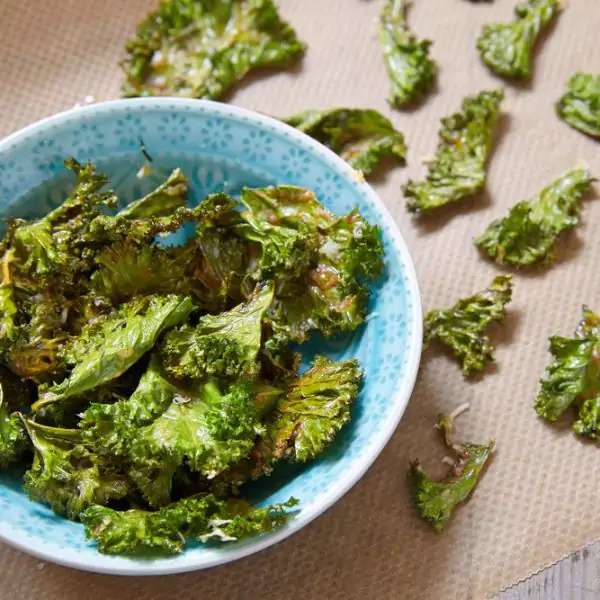
Kale is amongst the healthiest greensand just like any other dehydrated food, dried kale chips retain most of the nutrients. Kale chips are rich in nutrients like vitamin A, folate, and alpha-linolenic acid, to name a few.
These nutrients are responsible for various functions in the body, including strengthening eye and bone health, fortifying the immune system, and even brain development. When powdered, kale chips have a high bioavailability and pack-rich digestible fiber, which promotes healthy digestion and prevents constipation.
Dehydrated kale chips are also quite versatile when it comes to the foods you can prepare them with. These include;
- Snacks – Dehydrated kale chips alone are a great snacking option. You can even pre-season them with spices like garlic powder or nutritional yeast for a cheesy punch.
- Toppings – You can crumble dehydrated kale chips, pack them in an airtight jar and use them as a topping for many recipes. These include anything from soups to stews, smoothies, and even smoothies.
- Seasonings – Crumble or powder the kale chips to use them as seasonings for salads, stews, sauces, and soups. After all, during the dehydration process, you can season your kale with a variety of spices to give them an even better flavor punch.
- Eat them fresh – Dehydrating kale prolongs its shelf life. So, after a few weeks of storage in a vacuum-sealed container, you can rehydrate kale chips and cook them like regular kale. Simply transfer them to a bag or container, rehydrate them in hot water, and add them to foods like lasagnas.
How Long Do Dehydrated Kale Chips Last?
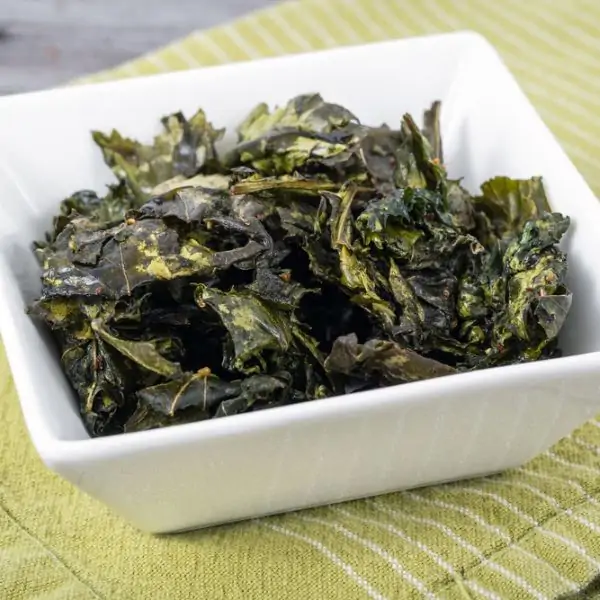
When stored at room temperature in an airtight container or bag, kale chips will last for about 2 to 7 days.
You can extend their shelf life by vacuum-sealing the chips, allowing them to last up to 6 months. Freezing is also another way to store kale chips for a long time, extending their lifespan to about 3 to 6 months.
How Long Does It Take To Make Kale Chips In A Food Dehydrator?
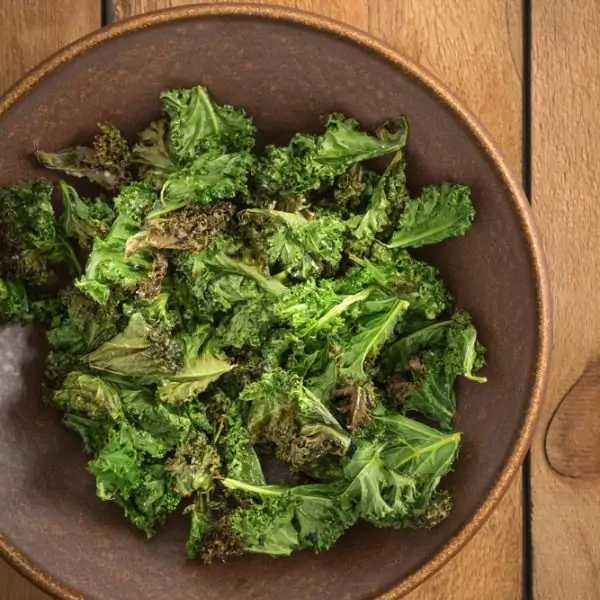
It takes about 4 to 24 hours to dehydrate kale chips in a food dehydrator. However, the actual duration depends on the method you use.
If you go for the regular method, it will take about 4 to 5 hours to dehydrate the chips. If you want your kale chips to qualify as raw food, you will have to use the low-temperature method which takes about 8 to 24 hours.
Key Factors In Dehydrating Kale Chips In A Dehydrator
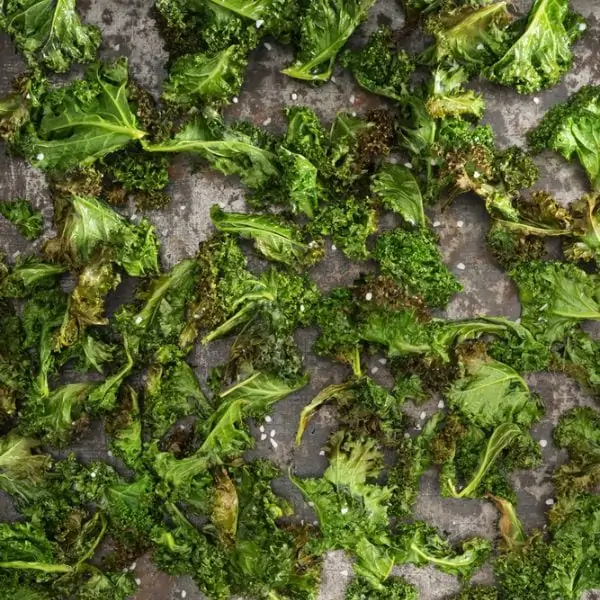
Several factors determine how successful your dehydration process will be. Some of the factors are standard, no matter the food you dehydrate.
These factors range from the type of dehydrator you use to size and temperature settings. But, there are also special factors to consider when drying kale chips.
Here’s what you want to keep in mind to get the best results:
Always Use Fresh Kale
Fruits like blueberries don’t really have to be fresh when you want to dehydrate them (although fresh ones yield the best flavors). You can also use frozen blueberries – just let them thaw first! This is not the same for kale.
Remember kale has high water content, which is why you have to remove the stems (they have higher water content) during the prep process. Now, freezing and later thawing the kale will render them soggy, making it impossible to dehydrate them.
Kale Chip Sizing Is Key
When preparing fresh kale for dehydrating, the size matters.
During the dehydration process and cooling down, kale chips will significantly shrink. So make sure you cut them at a reasonable size.
Consider the Dehydrator Type
Typically, dehydrators feature a horizontal or vertical flow. So, the type you go for depends on how you wish to prepare your kale chips.
For example, vertical flow models may require you to reposition the trays from time to time (at least once per session).
On the other hand, vertical flow dehydrators allow you to dry kale chips with varying seasonings on different shelves without contamination. Each vertical flow shelf will get the same heat exposure and will not drip food juices to the ones underneath or onto the heating element.
Keep The Kale Dry To Ensure Longer Lasting Storage
Whether you intend to keep kale for short-term or long-term storage, you have to make sure it is completely dry before and after dehydration. This means that both prep and storage are just as important as the actual dehydration process.
Never dehydrate the entire vegetable. Instead, remove the stalks as they are thicker (take longer to dry) and contain more moisture than the leaves.
Plus, stalks don’t have that much flavor in them! After cutting the leaves to the desired size, wash the fresh kale, remove any impurities, and dry it thoroughly.
You can lay them on a paper towel till dry or even use a salad spinner to expedite the process. Many recipes call for seasoning kale with oil and spices before drying it.
So, during this process, you want to use the oil sparingly as excess oil may also render your kale chips soggy prematurely. You can even use a spray bottle to control the output.
Further, if you choose to add extra seasonings in addition to the oil, avoid using liquid seasonings – always go for powdered seasonings or herbs. Nonetheless, unseasoned kale chips will last longer than seasoned ones.
Lastly, leaving space between each kale leaf on the drying tray and drying them at a lower temperature for longer ensures they are crisp enough and don’t soggy up quickly.
This process also ensures all the moisture is drawn out. Drying them at a high temperature will overdry them on the outside and leave them moist on the inside.
How To Make Kale Chips In A Food Dehydrator
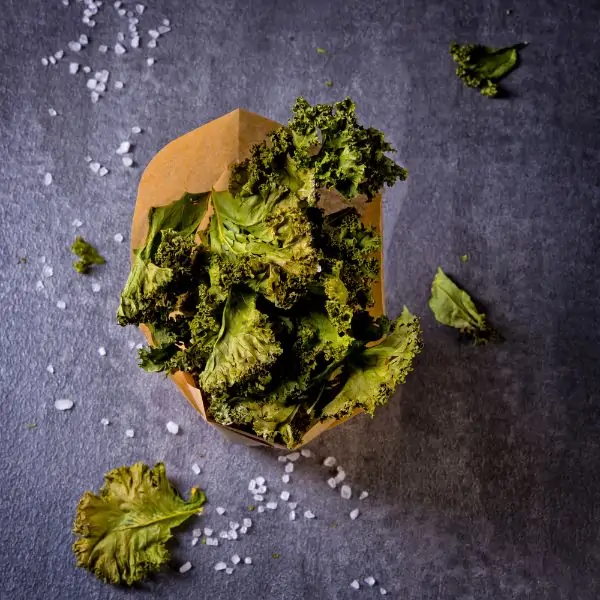
Here’s what you need to have and what you need to do to prepare kale chips in a food dehydrator:
Tools and Ingredients Needed
- Salad spinner or paper towels
- Utility knife
- Large mixing bowl or colander
- Tongs
- Oil spray bottle
- Dehydrator
- Fresh kale
- Extra virgin olive oil (healthy option)
- Sea salt
- Seasonings – for example, nutritional yeast, garlic powder, onion powder, lemon powder, paprika, or more flavored packed ranch seasoning, etc.
Duration
Preparation time: 30 minutes
Drying time: 4 hrs
Instructions
Here’s how you dehydrate kale chips;
Step 1: Clean and Prep the Kale
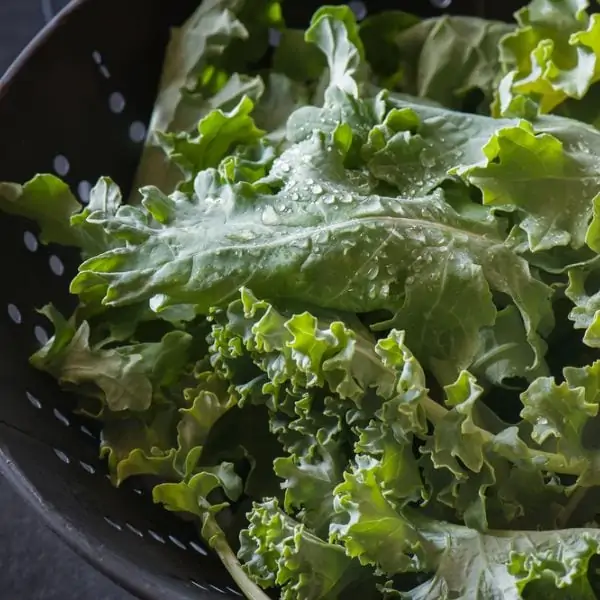
Thoroughly wash kale under clean running water and transfer it to a salad spinner to thoroughly dry it. Alternatively, you can strain it from the water and lay it on paper towels lined on the counter to air dry.
Next, once the kale is fully dry, de-stem it and use a utility knife or tear it with your hands into large chip-size pieces (at least 2 to 4 inches in size).
Step 2: Season the Kale
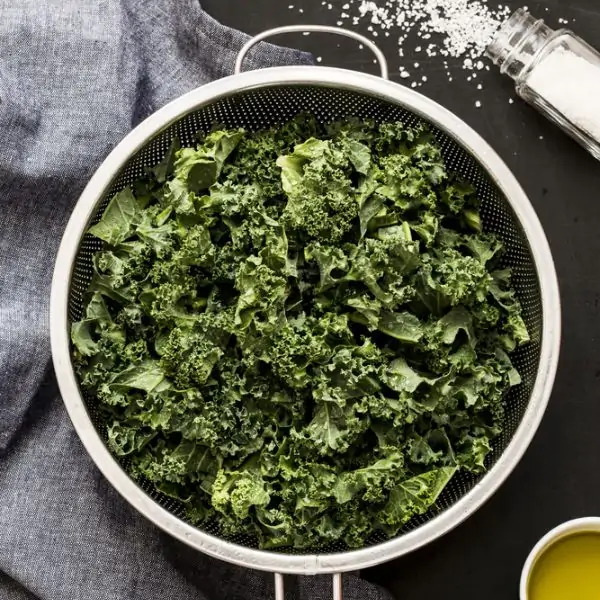
Transfer the chip-sized fresh kale pieces into a mixing bowl or colander, spray a very small amount of oil, and use a tong to toss the oil with kale till every piece is coated. Next, sprinkle the salt and lightly dust the kale seasoning you want, and toss them thoroughly.
Step 3: Dehydrate the Kale
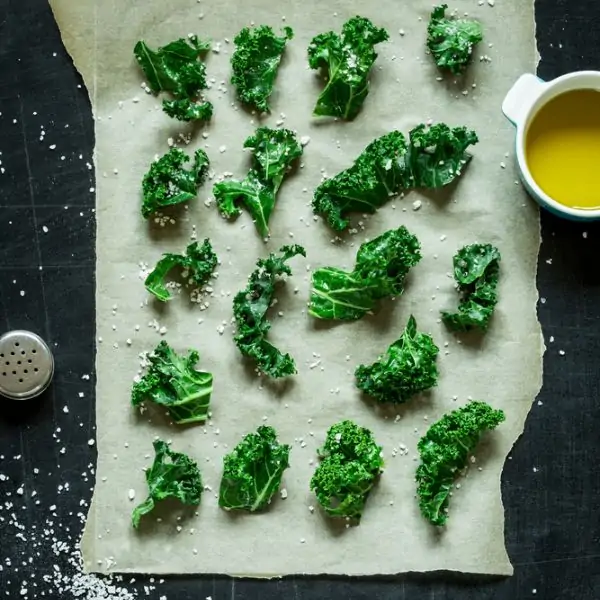
Line your dehydrator trays with parchment paper and transfer the seasoned kale, shaking off excess oil and seasoning.
Dry your kale for about an hour at 145 degrees Fahrenheit. Open the dehydrator and shuffle the tray positions if you are using a horizontal flow dehydrator.
Then, reduce the heat to about 115 degrees and continue drying for another 3 to 4 hours. By this time, your chips should be dry and crisp.
This process takes a relatively shorter time and so, kale chips made using this method do not qualify as raw food. If you want to prepare raw kale chips, follow the method below.
How To Make Raw Kale Chips In A Dehydrator
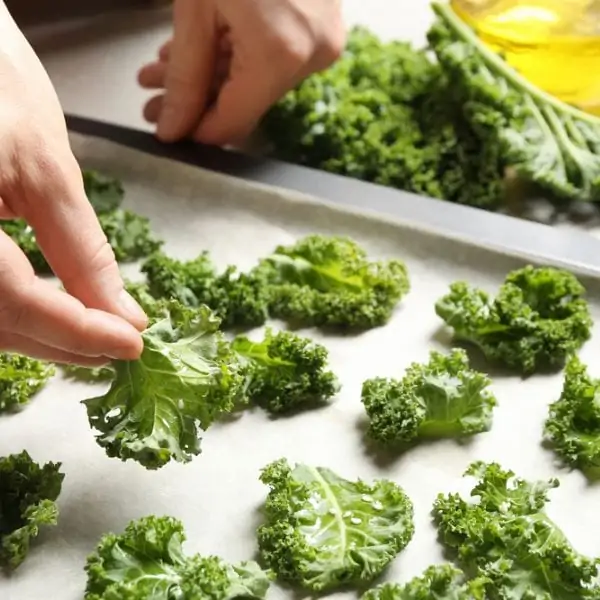
Drying raw kale chips in a dehydrator follows the same process as dehydrating regular kale chips in a dehydrator. However, the dehydrating time and temperature slightly vary.
To dry raw kale chips, use the low-temperature method. After lining the kale on the dehydrator trays, dry them at around 110 degrees Fahrenheit for about 8 to 24 hours until dry and crisp.
How Do I Know My Kale Chips Are Adequately Dehydrated?
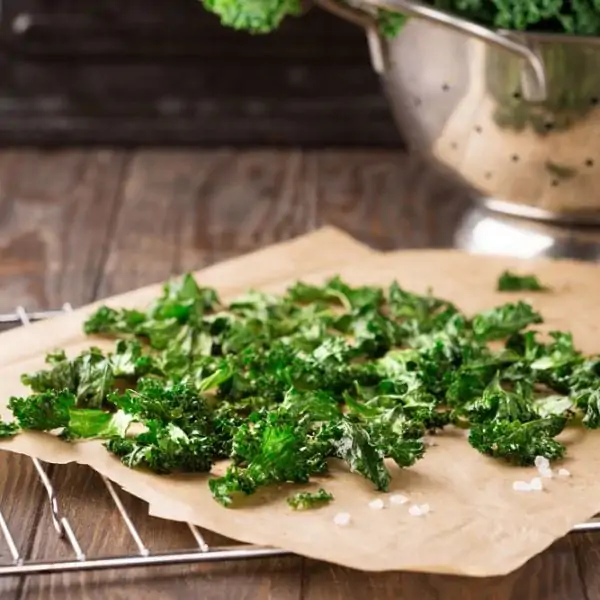
Adequately dehydrated chips should look dry and crisp.
Their color will also look saturated while their size shrinks. To know your kale chips are dry, think of the dead dry leaves during fall.
How to Store Dehydrated Kale
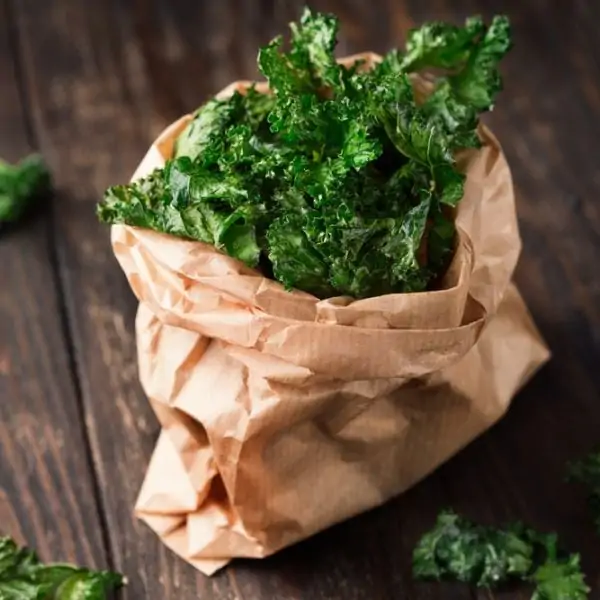
The way you store your dried kale determines how long it lasts. So you can keep your chips for short-term or long-term storage.
Short Term Storage
Once your chips are done, let them cool down in the dehydrator. Storing them right away while they are still hot will make them go limp, rehydrate, and become soggy.
Once the kale chips are cooled down, transfer them to a paper bag and store them for up to 7 days.
You should avoid storing the kale chips in a plastic bag or airtight container. Paper bags are a better idea due to their breathable material, allowing air to circulate and the chips to remain crispy without accumulating moisture.
Long Term Storage
For long-term storage, you can place the kale chips in a vacuum-sealed container to last you up to 6 months. Vacuum sealing kale chips in a container is better than a bag because the bag can easily crush them, turning them into kale flakes.
If you live in a warm, humid climate, you want to take extra precautions. To prevent humidity from ruining your kale chips, store them in an airtight container with reusable food-grade silica gel packs, moisture desiccant packs, or uncooked rice to help absorb the moisture.
Other Storage Options
You can find other ways to store kale chips if you don’t want to consume them as snacks alone. Freezing kale chips also work, allowing them to last for 3 to 6 months.
Simply, scrunch them into a baking or parchment sheet and freeze them until solid. Then, transfer them to an airtight freezer or vacuum-sealed freezer bag and store them till ready for use.
Remember, when you thaw the kale you can’t refreeze it as it would’ve rehydrated.
Kale chips can NEVER be refrigerated. This is because placing them in the fridge makes them accumulate moisture and rehydrate.
You can also grind or powder dried kale chips and store them in an airtight container for up to 6 months.
FAQs
Do you have more questions about dehydrating kale chips? Here are commonly asked questions to address more queries;
Why Are My Kale Chips Getting Soggy?
Kale chips get soggy when they aren’t properly prepared, dehydrated, or stored. This means that they can either contain a lot of moisture pre or post-dehydration.
To prevent this from happening, dry your kale at low temperatures over a long period, to render them dry and crispy.
How Do I Fix Soggy Kale Chips?
If you end up with soggy kale chips, there shouldn’t be a problem. If you don’t notice any visible mold, arrange them on a dehydrator tray and toss them back into the dehydrator for about an hour at 145 degrees Fahrenheit.
Alternatively, line the kale chips on a baking tray and toss them in the oven for about 5 to 10 minutes. Once you remove them from the dehydrator or oven, let them cool down and you should start to see them crisp up again.
How Do I Dehydrate Kale Chips Without A Dehydrator?
If you don’t have a dehydrator, there are plenty of other ways to dehydrate kale. You can dry kale chips under direct sunlight.
Alternatively, you can use other kitchen appliances, such as an oven, solar oven, air fryer, or microwave.
Of these methods, sun drying your kale chips will give you nearly the same results as a dehydrator and longer shelf life. However, sun drying kale takes significantly longer (several days) compared to using a dehydrator.
During the sun drying process, you will also have to constantly move the drying trays to protect the kale from the elements.
How Do I Dehydrate Kale Chips In An Air Fryer?
To dehydrate kale chips in an air fryer:
- Wash and thoroughly dry the kale using paper towels or a salad spinner
- De-stem it and tear the leaves into large chip-size pieces
- Spray extra virgin olive oil sparingly and massage it into each kale piece
- Sprinkle salt and your favorite seasonings and toss the kale pieces. You can do this step before or after dehydrating the chips and once they have cooled down.
- Transfer the kale pieces into an air fryer basket, leaving adequate space between each kale piece for optimal air circulation and drying. Cover the kale pieces with an air fryer rack to prevent them from flying around.
- Cook them at 375 degrees Fahrenheit for about 5 minutes until they are dry and crisp. Some air fryer models will even feature a special dehydrating setting you can pick.
- Let them cool down in the air fryer then serve or store them in a paper bag or plastic bag lined with paper towels for up to 7 days.
How Do I Dehydrate Kale Chips In An Oven?
- De-stem and tear fresh kale into large bite-size pieces
- Thoroughly wash fresh kale under running water and use paper towels, a clean cloth, or a salad spinner to dry it.
- De-stem it and tear the leaves into large chip-size pieces
- Lightly drizzle extra virgin olive oil onto the kale and coat each piece
- Sprinkle salt and seasonings lightly and toss the kale pieces. You can also do this after the drying process when the kale chips have cooled down.
- Transfer the kale pieces to a baking tray, arrange them in a single layer, and leave enough space between each piece.
- Bake the kale pieces at 225 degrees Fahrenheit for about 25 to 30 minutes. The point is to get the chips to dry and not burn. So, constantly check on them to ensure they don’t burn. Remember, when drying kale chips in the oven, you have to make sure the process is slow and with low temperatures. High temperatures and quick timing will only result in burnt chips or overly dried exteriors and moist interiors.
- Let them cool down in the air fryer then serve or store them in a paper bag or plastic bag lined with paper towels for up to 7 days.
Can You Rehydrate Kale Chips?
You can always rehydrate kale chips after drying them. All you do is transfer your kale chips to a plastic bag and rehydrate them in a hot water bath.
Rehydrated kale chips allow you to use them the same way you would use fresh kale.
Conclusion
Learning how to make kale chips in a dehydrator is a great way to add more flavors to your kitchen. Compared to store-bought kale, kale dehydrated at home is cheaper and natural, with no need of adding a plethora of preservatives.
Yet, it retains nearly the same nutrients as fresh kale. Plus, kale chips aren’t just great as healthier snack alternatives.
Their versatility allows you to use them in a wide range of recipes, whether as a flavor enhancer in a stew or soup topping.




